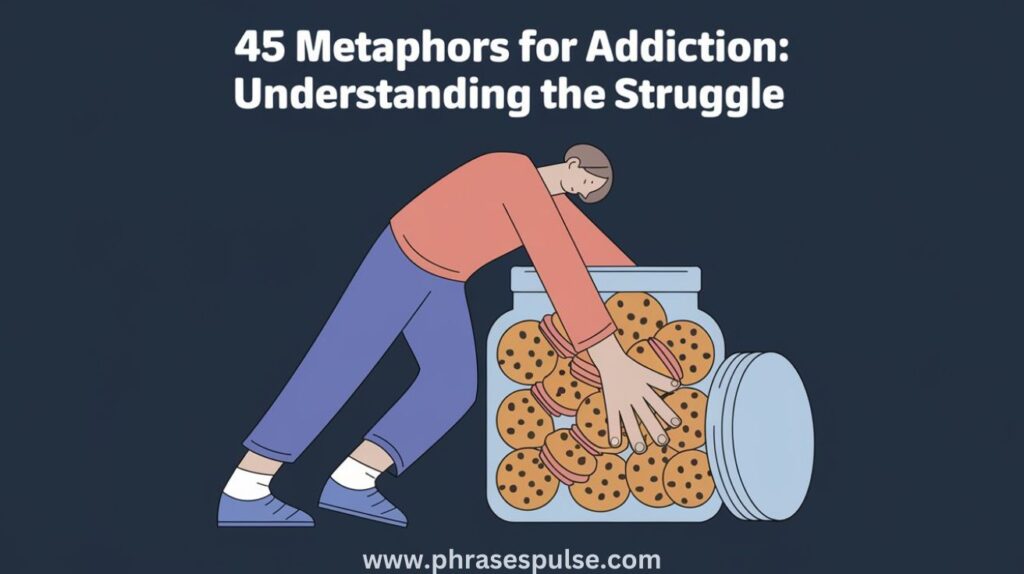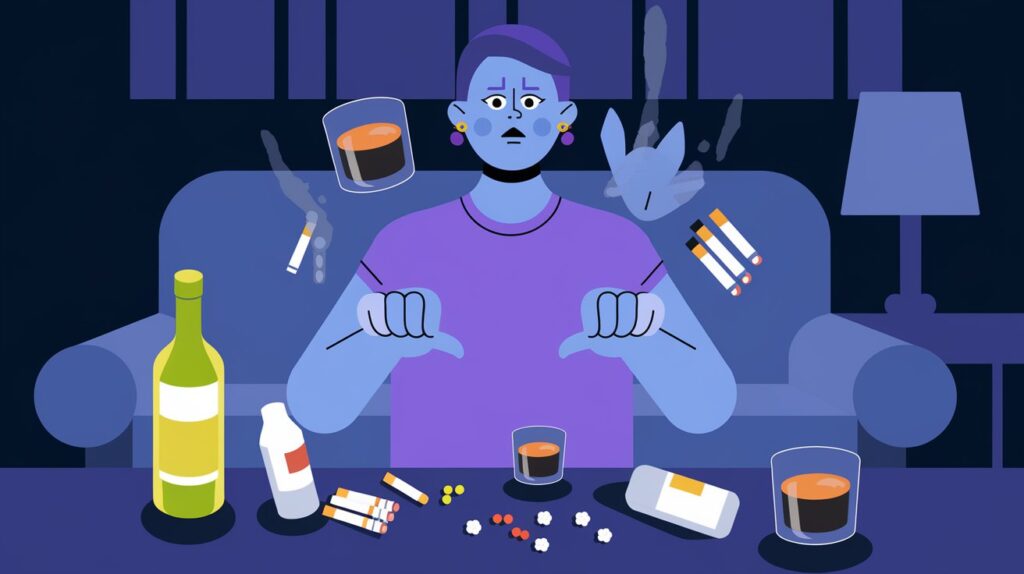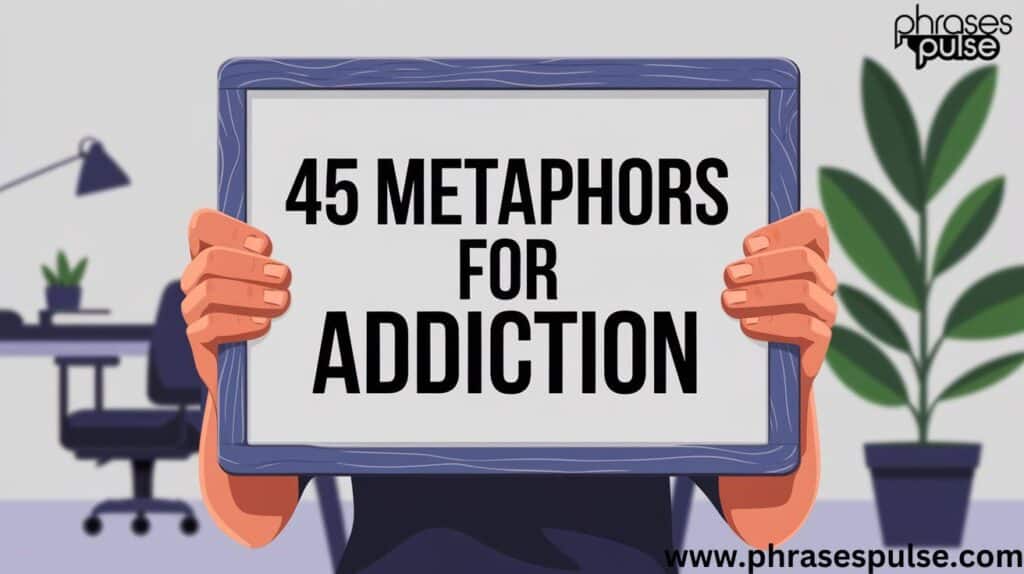Addiction is a profound challenge that impacts countless individuals, often leaving them feeling isolated and overwhelmed. In exploring “45 Metaphors for Addiction: Understanding the Struggle,” we can gain valuable insights into the emotional and psychological turmoil that accompanies this condition.
Metaphors serve as powerful tools to articulate the complexities of addiction, offering relatable imagery that helps convey the experiences of those affected. By delving into these metaphors, we can foster deeper understanding and empathy, paving the way for meaningful discussions about recovery and support.
Understanding Addiction and Its Metaphors

Before delving into the metaphors, it’s crucial to define what we mean by them. A metaphor is a figure of speech that describes an object or action in a way that isn’t literally true but helps explain an idea or make a comparison.
In the context of addiction, metaphors can effectively convey the restrictive nature of dependence, the emotional weight of cravings, and the gradual descent into habitual addiction.
Using figurative language allows individuals to express feelings and experiences that might otherwise be difficult to articulate. The right metaphor can encapsulate the feelings of longing for freedom, the addiction burden, or the chaos that comes from a persistent addiction.
45 Powerful Metaphors for Addiction

| Metaphor | Description |
|---|---|
| Chains of Dependency | Represents the restrictive nature of addiction. |
| Monkey on One’s Back | Illustrates the nagging presence of addiction. |
| Bottomless Pit | Signifies an unending cycle of cravings and despair. |
| Sinking Ship | Reflects the feeling of imminent disaster due to addiction. |
| Prison of Cravings | Highlights the mental captivity of addiction. |
| Siren’s Call | Represents the seductive lure of addiction. |
| Quicksand of Habit | Illustrates how easy it is to get stuck in addictive behaviors. |
| Poisoned Well | Signifies a source of relief that becomes toxic. |
| Vampire of Desire | Captures how addiction drains energy and happiness. |
| Vicious Cycle | Describes the self-perpetuating nature of addiction. |
| Pandora’s Box | Represents the unleashing of negative consequences from engaging with addiction. |
| Fiery Obsession | Reflects the all-consuming nature of addiction. |
| Wolf in Sheep’s Clothing | Highlights the hidden dangers of seemingly benign habits. |
| Black Hole of Need | Conveys the insatiable void created by addiction. |
| Dance with the Devil | Depicts the risky engagement with addiction. |
| Maze of Compulsion | Illustrates confusion and entrapment in addictive behaviors. |
| Tangled Web | Captures the complexity and deceit within addiction. |
| Jaws of Addiction | Signifies the inescapable grasp of addictive habits. |
| Puppet Strings | Emphasizes the loss of control due to cravings. |
| Slippery Slope | Highlights the ease of slipping into deeper addiction. |
| All-Consuming Fire | Captures the overpowering nature of addiction. |
| Albatross Around One’s Neck | Represents the burden of guilt associated with addiction. |
| Magnetic Pull | Signifies the irresistible attraction of substances. |
| Tightrope of Dependence | Reflects the precarious balance between use and abuse. |
| Whirlpool of Yearning | Illustrates the overwhelming pull of cravings |
Why Use Metaphors in Understanding Addiction?
Metaphors are not just decorative language; they serve several important purposes:
- Emotional Connection: They evoke feelings and experiences that resonate with readers, fostering empathy.
- Simplification: Complex concepts can become more relatable through simple comparisons.
- Facilitation of Dialogue: Metaphors create common ground for discussing difficult subjects.
By understanding these metaphors, we can begin to grasp the deeper implications of addiction and the deterioration of life that often accompanies it.
45 Powerful Metaphors for Addiction

1. Chains of Dependency
Addiction can feel like being bound by dependency chains that restrict freedom and choice. The individual may recognize their struggle, yet the chains tighten, making escape seem impossible.
2. Monkey on One’s Back
The phrase “monkey on one’s back” illustrates the nagging presence of addiction, always there, reminding one of their struggles and challenges. This metaphor captures how addiction can feel like an unwelcome companion that drains energy and joy.
3. Bottomless Pit
Many describe addiction as a bottomless pit, signifying a never-ending cycle of unquenchable cravings. The more one indulges, the deeper they sink into despair, making it difficult to find fulfillment or relief.
4. Sinking Ship
A sinking ship serves as a powerful metaphor for the feeling of imminent disaster that accompanies addiction. Just as a ship takes on water, individuals may feel overwhelmed by their struggles, facing the inevitability of sinking unless they find rescue.
5. Prison of Cravings
This metaphor highlights the mental prison that addiction creates. Individuals often feel trapped by their desires, unable to break free from the captivity of their cravings.
6. Siren’s Call
Like the mythical sirens that lured sailors to their doom, the seductive addiction calls to individuals with its irresistible allure. This metaphor emphasizes the danger of succumbing to temptation, often leading to dire consequences.
7. Quicksand of Habit
The quicksand of habit illustrates how easy it is to get stuck in a cycle of behavior that feels impossible to escape. As individuals struggle, they often find themselves sinking deeper into their entrenched behaviors.
8. Poisoned Well
Addiction can be likened to a poisoned well, a source of sustenance that becomes toxic over time. What once provided relief now only serves to harm, reinforcing the notion of addiction as a destructive force..
9. Vampire of Desire
This metaphor captures the idea of addiction as a vitality thief, draining energy and happiness. Much like a vampire, addiction consumes without giving back, leaving individuals feeling empty.
10. Vicious Cycle
The vicious cycle of addiction describes how one behavior leads to another in a self-perpetuating pattern. This cycle becomes a cyclic trap, where the quest for relief leads to more suffering.
11. Pandora’s Box
Opening Pandora’s Box is akin to entering the world of addiction. Once one engages, it unleashes a torrent of negative consequences that are often difficult to contain or reverse.
12. Fiery Obsession
The fiery obsession metaphor speaks to the all-consuming nature of addiction. Like a raging fire, it consumes everything in its path, leaving destruction in its wake.
13. Wolf in Sheep’s Clothing
Addiction often masquerades as a harmless escape, much like a wolf in sheep’s clothing. This metaphor underscores the hidden dangers of seemingly benign habits that can lead to significant problems.
14. Black Hole of Need
Describing addiction as a black hole of need conveys the insatiable void it creates. The more one attempts to fill this void, the deeper it becomes, leading to an ever-growing sense of despair
15. Dance with the Devil
Engaging with addiction can be seen as a dance with the devil—a risky and dangerous game. It reflects the conscious choice to indulge despite knowing the potential for destruction.
16. Maze of Compulsion
The maze of compulsion illustrates the confusion and entrapment that often accompany addictive behaviors. Finding a way out can seem impossible when surrounded by walls of desire.
17. Tangled Web
This metaphor captures the complexity of addiction, where every choice leads to further entanglement. Individuals may find themselves caught in a web of deceit, unable to see a clear path forward.
18. Jaws of Addiction
The jaws of addiction signify the inescapable grasp that these habits can have on an individual. Once caught, it can feel as though escape is no longer an option.
19. Puppet Strings
Addiction often manipulates individuals like puppets on strings, stripping away autonomy and control. This metaphor emphasizes the loss of agency and the sense of being directed by cravings rather than personal choice.
20. Slippery Slope.
The slippery slope metaphor highlights how easily one can slide into deeper addiction. A single indulgence can lead to a gradual descent into more significant problems, illustrating the difficult escape from these habits. .
21. All-Consuming Fire
An all-consuming fire captures the intense desire that can overpower rational thought. This metaphor reflects how addiction can become the central focus of one’s life, overshadowing everything else.
22. Albatross Around One’s Neck
The albatross represents a burdensome guilt that comes with addiction. Like the weight of a heavy bird, individuals often carry the addiction burden, feeling ashamed of their choices.
23. Magnetic Pull
The magnetic pull of addiction signifies how difficult it can be to resist. Just as a magnet draws objects toward it, the allure of substances can be impossible to ignore.
24. Tightrope of Dependence
Living with addiction often feels like walking a tightrope of dependence—one misstep can lead to a fall. This metaphor reflects the precarious balance individuals maintain between use and abuse..
25. Whirlpool of Yearning
The whirlpool of yearning illustrates the overwhelming desire that pulls individuals into the depths of addiction. Like a whirlpool, it can be hard to escape once caught in its current.
26. Venomous Embrace
Addiction can feel like a venomous embrace, where the initial pleasure is quickly overshadowed by pain and suffering. This metaphor emphasizes the deceptive nature of addiction.
27. Icy Grip
The icy grip of addiction represents the cold, unyielding hold it has on individuals. This metaphor captures the stark reality of feeling trapped and powerless.
28. Endless Hunger
An endless hunger signifies the perpetual craving for substances that can never be satisfied. This metaphor encapsulates the relentless pursuit of something that ultimately brings more pain than joy..
29. Wicked Seduction
Addiction can be a wicked seduction, drawing individuals in with false promises of happiness. This metaphor highlights the allure that masks the underlying dangers.
30. Blindfolded by Cravings
Being blindfolded by cravings speaks to the lack of awareness individuals often have about their addiction’s consequences. It illustrates how desires can obscure judgment.
31. Fleeting Shadow
Addiction often provides only a fleeting shadow of happiness, leaving individuals longing for something more substantial. This metaphor conveys the transient nature of relief found in substances.
32. Falling into the Abyss
Describing addiction as falling into the abyss captures the sense of despair and hopelessness that can accompany substance abuse. It symbolizes the depths of emotional turmoil and loss of control.
33. Caged Bird
The caged bird metaphor illustrates the feeling of being trapped in a situation with no means of escape. This comparison highlights the emotional toll of addiction, as individuals long for freedom.
34. Hurricane of Emotion
The hurricane of emotion metaphor portrays the chaotic feelings associated with addiction. Like a storm, addiction brings turmoil, confusion, and fear, affecting every aspect of life.
35. Desert of Isolation
Addiction often leads to a desert of isolation, where individuals feel alone in their struggles. This metaphor emphasizes the loneliness that accompanies substance abuse
36. Crumbling Fortress
The crumbling fortress illustrates how addiction erodes one’s defenses against life’s challenges. It highlights the fragility of self-control and the importance of support systems.
37. Fading Echo
hefading echo metaphor signifies the diminishing self as addiction takes hold. It reflects the loss of identity and the struggle to reconnect with one’s true self.
38. Chameleon of Deceit
Addiction can change its appearance, much like a chameleon of deceit. This metaphor underscores how easily it can disguise itself as harmless behavior.
39. Stormy Seas
Navigating the waters of addiction often feels like sailing through stormy seas. The turbulence reflects the unpredictable nature of recovery and relapse.
40. Sculptor of Suffering
Addiction acts as a sculptor of suffering, shaping one’s pain and experiences. This metaphor emphasizes how addiction molds lives, often leaving behind a trail of destruction.
41. Cloak of Despair
The cloak of despair represents the suffocating presence of addiction. This metaphor illustrates how addiction can envelop individuals, making it challenging to find hope.
42. Tidal Wave of Cravings
The tidal wave of cravings captures the overwhelming force of desire that individuals experience. Like a wave, cravings can crash over a person, leaving them gasping for breath.
43. Garden of Illusions
Addiction creates a garden of illusions, where temporary pleasures mask deeper issues. This metaphor speaks to the false sense of security that substances can provide.
44. Crimson Thread
The crimson thread metaphor signifies the connection between addiction and self-harm. It highlights the painful choices individuals may make in their struggle with addiction.
45. Endless Maze
The endless maze metaphor captures the confusion of navigating recovery paths. This imagery emphasizes the complex journey individuals face as they seek help and healing.
Engaging with the Metaphors
Metaphors allow individuals to articulate their experiences and connect with others facing similar challenges. Reflect on which metaphor resonates most with you or someone you know. It’s an opportunity to share experiences, foster understanding, and seek support.
Quiz: Test Your Understanding of the Metaphors
- What does the “bottomless pit” metaphor represent?
- How does the “prison of cravings” illustrate the experience of addiction?
- What are the implications of the “dance with the devil” metaphor?
- Can you identify a personal experience that aligns with one of the metaphors?
- Why is it important to discuss addiction using metaphors?
Conclusion
In conclusion, “45 Metaphors for Addiction: Understanding the Struggle” reveals the intricate layers of addiction through relatable imagery. These metaphors not only articulate the emotional and psychological challenges faced by individuals but also foster empathy and compassion.
By recognizing and sharing these powerful comparisons, we can create a more supportive environment for those affected. Ultimately, understanding these metaphors serves as a crucial step towards recovery, encouraging open dialogue and a collective effort to combat the burden of addiction.

Ava Rose, the creator of PhrasesPulse, is an expert in English grammar with years of experience. She is dedicated to simplifying complex grammar rules and exploring the richness of English phrases. Through her insightful posts, Ava aims to help learners of all levels enhance their understanding of the language and communicate more effectively. Her passion is making grammar approachable and enjoyable for everyone.







